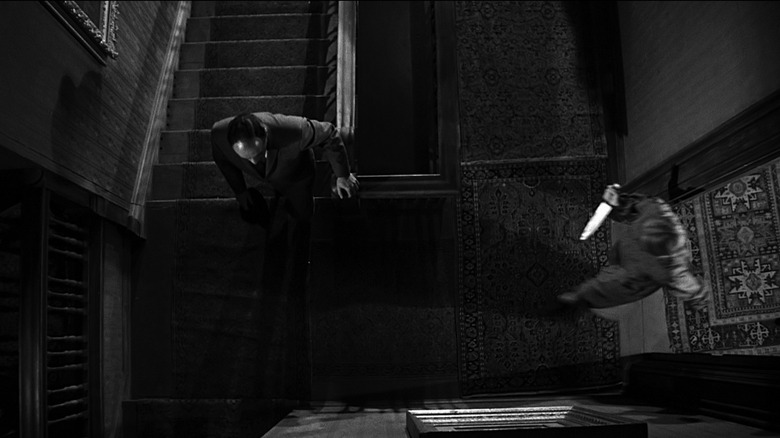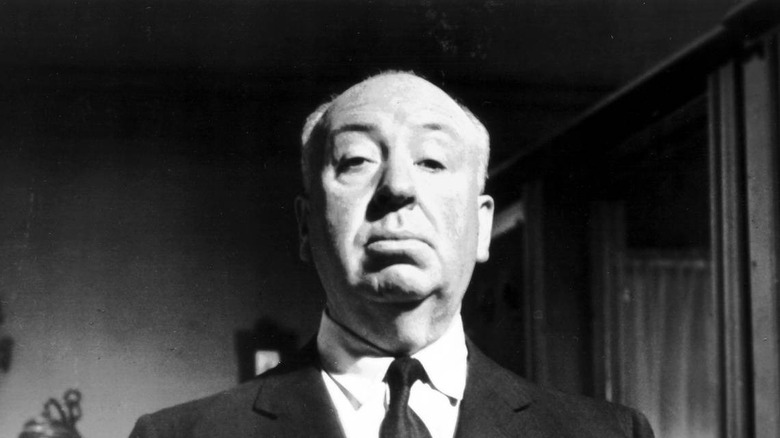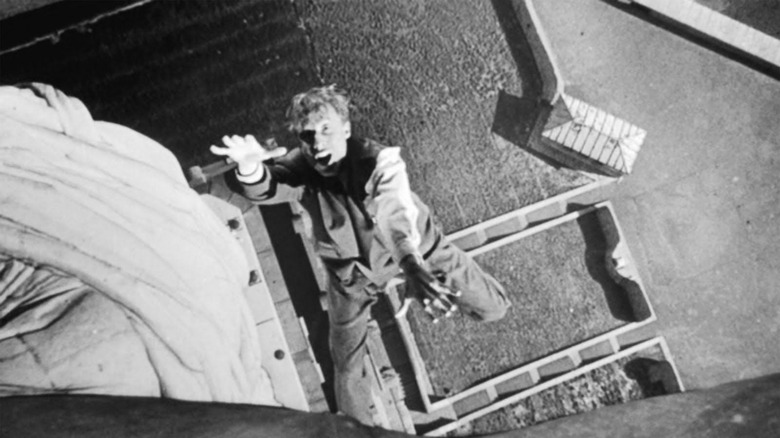How Alfred Hitchcock Pulled Off Psycho's Most Daring Stunt
Anyone who's seen Alfred Hitchcock's immortal "Psycho" instantly recalls "the shower scene," the shocking murder of Marion Crane (Janet Leigh) made even more brutal by Hitchcock's ingenious editing and Bernard Herrmann's iconic score. Yet Marion's death at the hands (and knifepoint) of "Mother" in a room at the Bates Motel is only one of two on-screen murders in the film. The other comes when a private investigator named Arbogast (Martin Balsam) investigates the motel, having been hired by Marion's sister, Lila (Vera Miles) to look into her disappearance. Arbogast interrogates the motel's owner and operator, Norman Bates (Anthony Perkins), who gives off a nervous and highly suspicious attitude.
Choosing to explore the creepy old house located next to the motel, Arbogast runs right into "Mother" while climbing the stairs to her room. As the detective is stabbed and then falls back down the stairs, Hitchcock cuts to a bravura shot that at first glance seems incredibly dangerous if not impossible: the camera follows Arbogast down the steps as if attached to him, the ground floor rushing forward at a rapid pace. As he collapses on the ground, "Mother" catches up to him, continuing to stab his body over and over. The shock and surprise of the scene comes in large part from its uniqueness. The way Hitchcock shot it is not only deceptively simple, but also utilizes a trick that he'd used before.
How to Create the Illusion of Falling, the Hitchcock Way!
Hitchcock had been working in the film industry for nearly 40 years by the time he made "Psycho," helming some of the greatest movies of all time along the way. In the process of pioneering a number of innovative narrative tropes and filming techniques, he gained an extensive knowledge of the camera and its ability to trick the human eye. So when it came time to film actor Martin Balsam making his fatal fall down the Bates manor stairs, Hitchcock knew that neither Balsam nor the camera had to actually fall at all.
What Hitchcock did was film the background of the scene first, a shot typically known as a "plate" due to it being intended for use with other elements on top of it. Then he had Balsam sit "in a very comfortable chair," the director cheekily explained in a 1972 interview with Dick Cavett, "and just lay there like that." Balsam was instructed to flail about with a gash of blood down the side of his face, his movements evoking the way that a falling person is "fighting the fall" and helplessly attempting to regain their balance. The scene was created by being "double printed," the character and background being married by Balsam's footage being shot while the background plate was rear projected behind the actor. This meant that the background footage was effectively filmed twice, causing it to look eerily out of focus when compared to the sharpness of Balsam in the frame. Hitchcock intended this spooky, surreal look for the sequence, and even sets it up just a few seconds before the murder happens as Arbogast climbs the stairs, with Balsam shot walking in front of a similar background plate of the house. Thus, Balsam's character dies in a violent, shocking, and memorable way without the actor or the crew ever being in danger.
How to Steal From Yourself, the Hitchcock Way!
Hitchcock was a filmmaker who fervently believed in expedience. He was infamous for completely storyboarding his films before a single frame had been shot, causing him to become bored during the actual production process. To that end, Hitchcock wasn't above reusing techniques he found effective: his next film after "Psycho," "The Birds," contains a sequence that essentially repeats the rhythms of the former's shower scene during a harrowing avian attack on Tippi Hedren.
So it's little surprise that the director had already shot a scene using a similar technique as Arbogast's murder some 18 years prior, in 1942's "Saboteur." In the climax of that film, the dastardly Frank Fry (Norman Lloyd) plunges to his death from the top of the Statue of Liberty. Hitchcock shot the scene nearly the same way, with Lloyd photographed while sitting in a small chair, leaning back and flailing instead of actually falling. "That's how actors earn their money, you see?" the director joked to Cavett. "By not having to do the things they're supposed to do." Whether it's the death of Fry or Arbogast's murder, Hitchcock's clever techniques prove that daring stunts can be accomplished with a minimum of danger.


